#New indian
Text
Wikipedia editors push offensive language to delegitimize some Native American Tribes






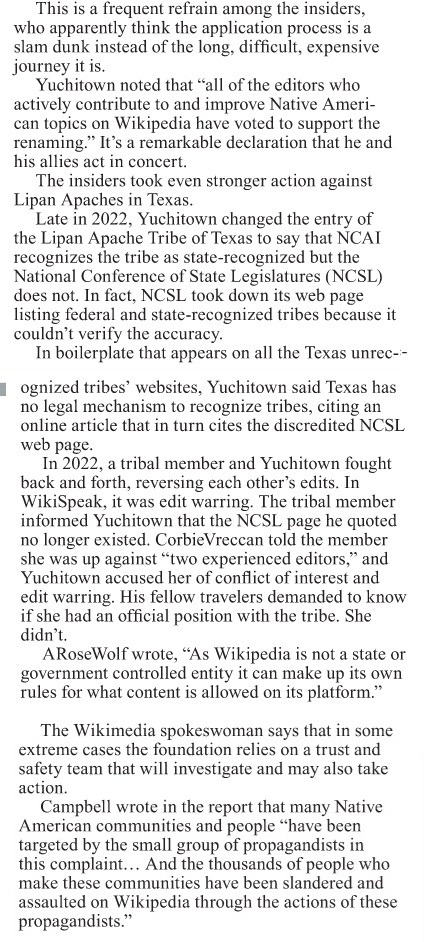
Article Text As Follows:
Wikipedia editors push offensive language to delegitimize some Native American Tribes
By Sherry Robinson
Special to The Independent
ALBUQUERQUE — When Lily Gladstone won a Golden Globe and Oscar nomination for her role in “Killers of the Flower Moon,” the public recognized a Native American actress. But to Wikipedia readers, she is an American actress whose father was Blackfeet and Nez Perce and whose mother was white.
Three long-time editors at the online encyclopedia argued that even though Gladstone grew up on the Blackfeet reservation, she couldn’t be called Native American unless she was an enrolled member of the tribe. When Gladstone’s uncle weighed in to say she was enrolled, they dismissed his comments. She is still, in Wikipedia’s view, “an American actress.”
In recent years, outside of a national debate in Indian Country over fake tribes, a handful of Wikipedia editors have been deciding who is Native American and who isn’t.
Look behind the curtain of the sprawling site and you will find a network of 265,000 volunteer editors writing and editing within a Wiki universe that has its own rules, language, police and courts but no traditional hierarchy.
Wikipedia’s structure allows likeminded editors to work together, but it also permits editors with a bias to advance their agenda. The site has drawn criticism from media and academics for slanted articles on Blacks and Jews. Wikipedia documents its own systemic bias in an article by that name and attributes the problem to too few minority editors. The typical editor, it says, is a white male.
By Wikipedia's definition, the only real tribes are federally recognized; editors of Native American material denigrate state-recognized and unrecognized tribes and seem preoccupied with revealing fake Indians.
The fakes are out there, and they’re a problem. But there’s a big difference between people who invented a Native ancestry and people who have a long, documented heritage.
For this story, aggrieved tribal members didn’t identify themselves because they fear the site’s size and power – it reaches 1.8 billion devices a month – and some editors’ vindictiveness.
Behind the curtain
Wikipedia is transparent about its process. Click on “talk” at the top of each article and you find the (sometimes endless) debates among editors about an article and see the site’s rules in action.
Editors are anonymous because the Wikipedia Foundation has a strong commitment to privacy, says a spokesperson. However, readers don’t know what expertise editors have or whether they’re Native American.
Editors select their subject matter. With experience they can rise in the pecking order until they gain authority to reverse or eliminate the edits of others. They quote the site’s often arcane rules in Wiki-Speak to anyone who disagrees. While Wikipedia espouses objectivity, neutrality and civility, discussions can take the low road.
On Lily Gladstone’s talk page, a newish editor, user name Tsideh (Apache for bird), asked, “What are your sources supporting the idea that Native Americans are only those who are enrolled in a US recognized tribe?”
A Wiki editor, user name ARoseWolf, answered: “A notable subject can make a claim… but you must have that respective tribal nation’s acceptance as verification through enrollment."
Gladstone’s uncle wrote: “I’m a primary source for Ms. Gladstone’s tribal heritage. Her father is my brother. Through our father, we are both enrolled in the Blackfeet Tribe in the USA,” he wrote. “Our mother is enrolled Nez Perce. So Ms. Gladstone is a direct descendant of both Blackfeet and Nez Perce.”
ARoseWolf shot him down. “We can not use primary sources to verify such information and, you, as a claimed family member have a WP:COI which means we need an independent source.”
WP:COI is the Wikipedia rule on confl ict of interest. Wikipedia forbids primary sources, and yet they’re the gold standard for journalists and academics.
Tsideh challenged the position that only enrollment in a recognized tribe “entitles somebody to claim to be a Native American” as an unfounded, minority point of view that Wiki editors didn’t support with a citation or explanation.
ARoseWolf and others chastised Tsideh for violating Wiki rules on bullying, false accusations and arguing Wiki policy. Tsideh countered that Leonardo DiCaprio didn’t have to prove he was an Italian American, but Lily Gladstone had to prove she was a Native American.
As the back and forth continued, ARoseWolf slammed a new editor who "just happened to find this discussion,” a dig that implies one party enlisted another to join the debate. That too is a Wiki violation.
Bohemian Baltimore, another regular, insisted, “If she’s not enrolled, she may be a descendant, but she’s not a Native American.”
Who is Native American?
Terry Campbell, a Navajo born in Tuba City, Arizona, who lives out of state, has been studying Wikipedia for five months, after friends complained about poor treatment in trying to edit Wiki pages.
One friend wanted to add some facts to an article about a tribe. “These changes were rejected by a handful of editors who cited other Wikipedia pages as sources,” he said, “and I thought that was very, very odd.”
A friend citing sources that prove her tribe survived the Indian wars and received state recognition ran up against Wikipedia guidelines on determining Native American identities that were largely crafted by two editors, user names CorbieVreccan and Yuchitown. Wiki editors used the guidelines to reclassify dozens of state-recognized tribes as “heritage organizations” and removed “Native American” from biographies of prominent tribal members or, worse, called them a "self-identified Native American.”
The implication, Campbell explained, is that the tribe no longer exists and that its members are suspect or even “Pretendians.” Wikipedia has a page for that too.
The same group has shaped many articles on Native subjects. Campbell said he combed through references and found they were misrepresented, taken out of context, sourced from far-right academics, or unreliable.
“The scope of this issue is huge,” Campbell said. “It permeates all the Native articles I checked.”
Campbell recognized talking points from what he called a far-right movement in Indian Country intent on erasing state-recognized and unrecognized tribes. (New Mexico has no state-recognized tribes and six unrecognized groups or tribes.)
Some Native Americans and Anglos, he said, believe that Indigenous people outside the circle of federal recognition should be considered non-Native. They also want to prevent members of the disenfranchised groups from selling their art, receiving ancestral remains, accessing disaster relief or re-establishing their homeland.
Outside Indian Country, it’s not generally known that U.S. Indigenous groups live within a caste system based on government recognition, with 574 federally recognized tribes on top, dozens of state-recognized tribes second, and several hundred unrecognized tribes last.
In 2021, Yuchitown wrote, “The overwhelming majority of ‘List of unrecognized tribes in the United States’ are completely illegitimate.”
There are many reasons why groups aren’t recognized. Some avoided the reservation. Some lost their recognition during the termination era. Some were broken up and scattered during the Indian Wars. Some went underground, practicing their culture secretly while passing as Hispanic. Many simply stayed put.
When Wikipedia editors claim that “Native American” is a political status conferred by the U.S. government, that an individual can only be called a “descendent” until their tribe is recognized, they push this narrative, Campbell said. It’s a contradiction of federal Indian law and the United Nations Declaration on the Rights of Indigenous Peoples.
According to the U.S. Department of Justice, “As a general principle, an Indian is a person who is of some degree Indian blood and is recognized as an Indian by a Tribe and/or the United States. No single federal or tribal criterion establishes a person’s identity as an Indian. Government agencies use differing criteria to determine eligibility for programs and services. Tribes also have varying eligibility criteria for membership.”
Extreme points of view
Campbell has contributed to a lengthy report, as yet unpublished, that identifies biased editors. They include Yuchitown, CorbieVreccan, ARoseWolf, Indigenous girl and Bohemian Baltimore.
“It was like a tree with many interconnecting branches that had been created over time by the same small group of people pushing extreme points of view,” Campbell said.
Initially the group made changes slowly, he said, “but they started pursuing their agenda aggressively after November, when state-recognized tribes retained their voting rights in the National Congress of American Indians (NCAI). Essentially, after the movement to delegitimize state-recognized tribes failed officially, the key players doubled down on altering and controlling the flow of information about Native Americans through Wikipedia.”
Campbell observed widespread violations of Wikipedia standards: “I found evidence that they blatantly misquoted and misrepresented sources to push extremist political beliefs; teamed up to manipulate the consensus system by voting in blocks; exploited Wikipedia rules, such as conflict of interest, to block outside editors from making changes to Native-related pages; excessively cited opinion pieces from fringe political figures, including those accused of racism and anti-semitism; blocked the use of legitimate primary and secondary sources that contradict their extremists beliefs, which violates Wikipedia’s rule against information suppression; posted originally researched, politically motivated essays instead of well-sourced articles; and harassed and defamed Native American tribes and living Native American people.”
Reacting in February to an early draft of the report posted on Google, the editors were incensed that anybody would voice complaints “off-Wiki.” ARoseWolf wrote that “we have been attacked, threatened with legal action and had misinformation/ false claims spread against us.” She and Yuchitown denied being part of a conspiracy against tribes or organizations and said they were just following Wiki rules. Yuchitown accused critics of being “meat puppets” of a person who objected to some Native content and enlisted others to back them up. In WikiSpeak this is meat puppetry.
“Volunteers on Wikipedia vigilantly defend against information that does not meet the site’s requirements,” the Wikipedia spokeswoman wrote. “These volunteers regularly review a feed of real-time edits to quickly address problematic changes; bots spot and revert many common forms of negative behavior on the site; and volunteer administrators (trusted Wikipedia volunteers with advanced permissions to protect Wikipedia) further investigate and address negative behavior. When a user repeatedly violates Wikipedia policies, Wikipedia administrators can take disciplinary action and block them from further editing.”
Inaccurate and insulting
In 2006, Wikipedia established the WikiProject Indigenous Peoples of North America to improve its Native-related content of 14,000 articles and more than 37,000 pages.
Recently, a hot topic on the project’s talk page was a proposal to change a category name from “unrecognized tribes” to “organizations that self-identify.”
On April 15 Melissa Harding Ferretti, chairwoman of the Herring Pond Wampanoag Tribe in Massachusetts, wrote, “The proposed renaming of the category on Wikipedia is not only inaccurate… but also insulting.”
Ferretti is one of the few Natives to take on Wiki editors openly.
Herring Pond was originally listed with other Wampanoag tribes. In 2022 Yuchitown stripped “state-recognized” from the page, even though the state Commission of Indian Affairs regularly engages with them. Last year Yuchitown created a separate page for Herring Pond. Wiki editors resisted attempts to make changes or corrections.
After Wikipedia called Herring Pond a “cultural heritage group" and a nonprofi t that "claims" to descend from Wampanoags, Ferretti wrote in a Wiki discussion, “There is no claim, it’s a fact! Might I add, nonprofit status was imposed upon Tribal nations in the ‘90s because we didn’t have our federal recognition yet.”
Her tribe has a well-documented history. “We still have care and custody of our sacred places, burial grounds and our 1838 Meetinghouse, one of three built for the Tribe after the arrival of the colonizers. Our continuous presence and stewardship of these lands are recognized by historical records, deeds and treaties.”
Ferretti wrote that tribes without federal recognition already face significant hurdles to gain recognition, "and being labeled as 'self-identified' can add to these challenges by casting doubt on our legitimacy.” Mislabeling unrecognized tribes “can lead to the spread of hate, misinformation and further marginalization.”
Some Wiki editors agreed. One wrote that “there are strong negative connotations to saying someone who is Native 'self identifies,' because the inference is that they are Native in name only or falsely claiming to be Native. A change like this will impact countless articles…” Bohemian Baltimore, ARoseWolf and Yuchitown insisted there were no negative connotations. They opposed calling an unrecognized group a tribe because it legitimized groups with unverified claims. ARoseWolf said, “If they had proof of their connection to the original people they would have gotten federal recognition.”
This is a frequent refrain among the insiders, who apparently think the application process is a slam dunk instead of the long, difficult, expensive journey it is.
Yuchitown noted that “all of the editors who actively contribute to and improve Native American topics on Wikipedia have voted to support the renaming.” It’s a remarkable declaration that he and his allies act in concert.
The insiders took even stronger action against Lipan Apaches in Texas.
Late in 2022, Yuchitown changed the entry of the Lipan Apache Tribe of Texas to say that NCAI recognizes the tribe as state-recognized but the National Conference of State Legislatures (NCSL) does not. In fact, NCSL took down its web page listing federal and state-recognized tribes because it couldn’t verify the accuracy.
In boilerplate that appears on all the Texas unrecognized tribes’ websites, Yuchitown said Texas has no legal mechanism to recognize tribes, citing an online article that in turn cites the discredited NCSL web page.
In 2022, a tribal member and Yuchitown fought back and forth, reversing each other’s edits. In WikiSpeak, it was edit warring. The tribal member informed Yuchitown that the NCSL page he quoted no longer existed. CorbieVreccan told the member she was up against “two experienced editors,” and Yuchitown accused her of conflict of interest and edit warring. His fellow travelers demanded to know if she had an official position with the tribe. She didn’t.
ARoseWolf wrote, “As Wikipedia is not a state or government-controlled entity it can make up its own rules for what content is allowed on its platform.”
The Wikimedia spokeswoman says that in some extreme cases the foundation relies on a trust and safety team that will investigate and may also take action.
Campbell wrote in the report that many Native American communities and people “have been targeted by the small group of propagandists in this complaint… And the thousands of people who make these communities have been slandered and assaulted on Wikipedia through the actions of these propagandists.”
Link to the original article:
6K notes
·
View notes
Text
"The Seychelles has become a major tourist destination for beachgoing and scuba diving, but it’s not only humans that are beginning to flock to this island.
In what marine biologists have described as a “phenomenal finding,” a survey of whales around the territorial waters of this archipelagic nation revealed the presence of blue whales—over a dozen.
It’s the first time they’ve been seen in these warm seas since 1966, and it’s a wonderful milestone in a long and increasingly successful recovery for the world’s largest animal.
The Seychelles are located in the Indian Ocean off the east coast of Africa, and they were historically a stopover point for Soviet whalers en route to Antarctica. The years 1963 to 1966 were particularly difficult for whales here, and many were taken before the International Convention on the Regulation of Whaling put an end to the practice of hunting baleen whales in 1973.
Since 1966, no dedicated investigation of whales in the Seychelles had been made until 2020, when a partnership of four universities conducted an acoustic survey over the period of two years.
They made five different sightings of groups of up to 10 animals.
“This was a phenomenal finding,” Jeremy Kiszka, a co-author of the paper from Florida International University, wrote in The Conversation. “We were prepared to not see any blue whales due to the high level of hunting that occurred fairly recently and absolutely no information was available since the last blue whale was killed in the region in 1964.” ...
The team behind the survey sent images taken of the whales’ dorsal sides to a database to see if any of them had been recorded before, and amid the reel, not a single one was a match with any other photographed whale.
This, the team suggests, means they have probably never been seen before, which for a species that big might seem strange, but along with there being only 5,000 to 15,000 on Earth, they migrate vast distances while diving deep, making recording their movements incredibly challenging.
The survey identified 23 whale species in total using hydroponic mics over 2 years with peak activity coming between December and April. This is a fascinating finding that suggests something about the seas around the Seychelles makes for excellent whale habitat."
-via Good News Network, April 30, 2024
#whales#blue whales#animals#marine life#marine biology#sea creatures#cetacean#seychelles#indian ocean#conservation#endangered species#whaling#conservation news#climate hope#good news#hope
919 notes
·
View notes
Text

#narendra modi#desiblr#desi humor#desi girl#desi tag#being desi#desi memes#india elections#indian elections#elections#election 2024#bjp#anti bjp#Congress#desi tumblr#lol#.jpg#india news#indpol#indian politics
602 notes
·
View notes
Text

This is a metal snail (Volcano Snail) that lives on underwater volcano vents in the Indian Ocean. Its shell and scaly feet both are armoured with layers of iron, making it the only animal to incorporate iron sulfide into its skeleton 🐌
📷: Dr Chong Chen/IUCN
#snails#snail life#snail#iron snail#oceans#indian ocean#science#news#research#biodiversity#iucn#iucn red list#science acumen#wildlife biologist#marine biology#biology#volcano#active volcano#amazing
4K notes
·
View notes
Text
THREE NEW SHARK SPECIES THIS WEEK!
The second week of July 2023 something extraordinarily beautiful happened, the findings of 3 new species of sharks for were announced
A new angel sharks species was identified, from the western Indian Ocean on the Mascarene Plateau and off southwestern India in 100–500 m depths, the Lea’s angel shark Squatina leae, was recognized to be different genetically and morphologically distinct from its congeneric species Squatina africanae, following unique morphological features. This species was first detected in 1988 after finding three unusual, small sharks, but till today was completely understood. The angel shark is named after one of the author’s fiancee’s late sister, Lea-Marie Cordt.

- Squatina leae, adult male, in dorsolateral.
Angel sharks are “flatter sharks”, possesing distinctly broad, dorsoventrally flattened bodies, a short snout with large mouth and nostrils, eyes on top of the head close to the large spiracles, very large pectoral fins, and a lateral caudal keel. They've evolved to be ambush predators, they lie in wait for prey to pass closely overhead before attacking.
Reference (Open Access): Weigmann et al., 2023. Revision of the Western Indian Ocean Angel Sharks, Genus Squatina (Squatiniformes, Squatinidae), with Description of a New Species and Redescription of the African Angel Shark Squatina africana Regan, 1908. Biology
From North Australia, another species of hornshark is described based on six whole specimens and a single egg case. The painted hornshark Heterodontus marshallae was previously considered to be the same with the zebra bullhead shark another well know bullhead shark from the central Indo-Pacific from Japan to Australia, but genetic and morphological analyses indicated the sharks were different, but looking alike. The painted hornshark is endemic to northwestern Australia and occurs in deeper waters, at 125–229 m below surface.

- Lateral view of two mature female painted hornshark Heterodontus marshallae showing small differences between individuals
The painted hornsharks is named in honour of Dr. Lindsay Marshall www.stickfigurefish.com.au a scientific illustrator and elasmobranch scientist who expertly painted all the sharks and rays of the world for the Chondrichthyan Tree of Life Project.
Reference (Open Access): White et al., 2023 Species in Disguise: A New Species of Hornshark from Northern Australia (Heterodontiformes: Heterodontidae). Diversity.
And from an unidentified shark egg collected from the deep waters of northwestern Australia, in 2011 recently helped researchers identify a new species of deep water cat shark. Called ridged-egg catshark Apristurus ovicorrugatus after its eggs, it was collected in the earlys 90 but remained unknown to date. This sharks presents white eyes, and is small in size, reaching less than a half meter in length. .
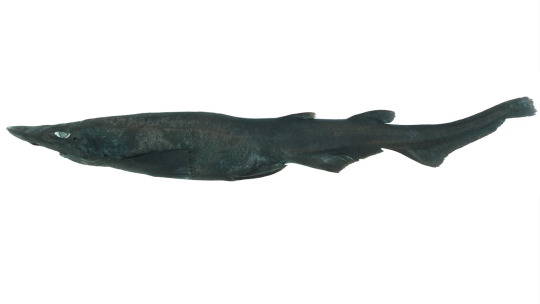
- Lateral view of female Apristurus ovicorrugatus before preserved. Photo by CSIRO.
Egg cases belonging to this species had been documented as early as the 1980s, but could not be matched to any species of Australian shark until recently scientists examined a shark specimen of previously uncertain identity in the CSIRO collection.

-egg cases of Apristurus ovicorrugatus. Scale bar is 10 mm
Reference (Open Access) White,et al., 2023 What came first, the shark or the egg? Discovery of a new species of deepwater shark by investigation of egg case morphology. Journal of Fish Biology.
#Squatina leae#Squatina#new species#elasmobranch#shark#biology#marine biology#science#marine science#indian ocean#bioblr#sciblr#sci#painted hornshark#Heterodontus marshallae#Heterodontus#Apristurus ovicorrugatus#Apristurus#long post#Ridged-egg catshark#Lea’s angel shark
3K notes
·
View notes
Text
Walking out of the theatre after watching two hours of Dev Patel kick ass, fueled by grief for his mother, the power of trans people in India, and his own righteous fury:
*sobbing* "I forgot movies can be good."
#monkey man#the monkey man#dev patel#guess who has a new favorite fight scene?#didn't know I needed to see a bunch of trans women#beat the shit outta bad guys#while Indian metal plays in the background#but DEV PETAL KNEW#and I will be forever grateful
764 notes
·
View notes
Text

The warmongering US
#The warmongering US#warmongers#usa news#usa politics#usa is a terrorist state#usa#american indian#american#america#ausgov#politas#auspol#tasgov#taspol#australia#fuck neoliberals#neoliberal capitalism#anthony albanese#albanese government#united states#unitedstateofamerica#unitedsnakes#united states of america#united states of whatever#united states of israel#class war#wariscapitalism#waristerror#global warming#war is real
597 notes
·
View notes
Text




Edit:


#yemen#jerusalem#tel aviv#current events#palestine#free palestine#gaza#free gaza#news on gaza#palestine news#news update#war news#war on gaza#red sea#red sea blockade#indian ocean blockade#mediterranean sea#ansar allah#ansarallah#houthis#edited
488 notes
·
View notes
Text

Adorable East Indian Girl!. OMG.... she's so pretty!
#delhi#east indian#indian beauty#bengali#trans is sexy#new delhi#mumbai#karnataka#india love#india#transgirl#transgenderwoman#transgender#trans community#guys in dresses#love is love#intersex#trans is beautiful#gay fashion#gay girls#transsexual#queer culture#trans pride#queer fashion#queer fashion#queer girl#lgbtqia#queer pride#lgbtq community
535 notes
·
View notes
Text
friendly reminder that India didn’t even have diplomatic relations with Israel till the 90s and had previously denied them visas. supplying them with drones in 2020s is a frighteningly short time for our government to change the fabric of our state.
#we used to be a proper country#we had palestinian stamps#wtf#free palestine#free gaza#on the recent news of indian drones & israeli usage
362 notes
·
View notes
Note
Hello. I would like to request either old soft ginhiji or desi / bollywood ginhiji. Though anything you draw is a blessing, so I will be happy with anything honestly, lol.
hello op i don’t think you realise the amount of brainrot your ask has inflicted upon me



ive had desi gintama dormant in my brain for a while so thank you for unleashing my brainworms. More will come soon
#dedicated to all my fellow indian gintama fans: i gotchu#everytime i get into something new there is a period of time where i desify everyone involved#this time has come once again#bollywood dramafication of gintama#this is euphoric to me i have so much silly shit to show off soon hehehehe#HOPE YOU ENJOY#sakata gintoki#hijikata toushirou#ginhiji#gintoki x hijikata#hijigin#hijikata x gintoki#gintama#ok bye#nimki talks#ask doodles
383 notes
·
View notes
Text
For #SaveTheElephantDay on #TwoForTuesday 🐘🐘:

Amrita Sher-Gil (Hungarian-Indian, 1913-1941)
Two Elephants, 1940
Oil on Canvas, 46cm X 54.3cm
National Gallery of Modern Art, New Delhi, India
#animals in art#animal holiday#20th century art#elephant#elephants#pair#modern art#painting#oil painting#1940s#women artists#Indian art#Amrita Sher-Gil#National Gallery of Modern Art New Delhi#Two for Tuesday#Save the Elephant Day
204 notes
·
View notes
Text
you don't fight fascism because you're going to win, you fight fascism because it's fascism.
- Jean-Paul Sartre

#desiblr#indian elections#bjpmafia#desi tumblr#palestine#free palestine#rafah#palestine news#jerusalem#free gaza#tel aviv
102 notes
·
View notes
Text

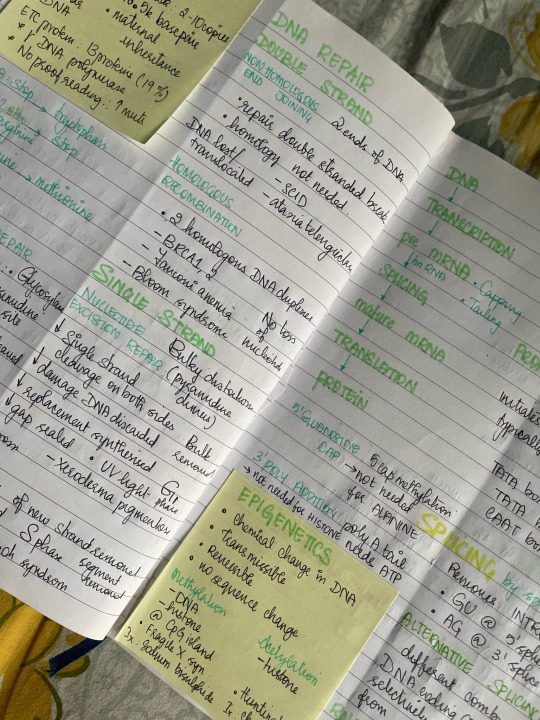
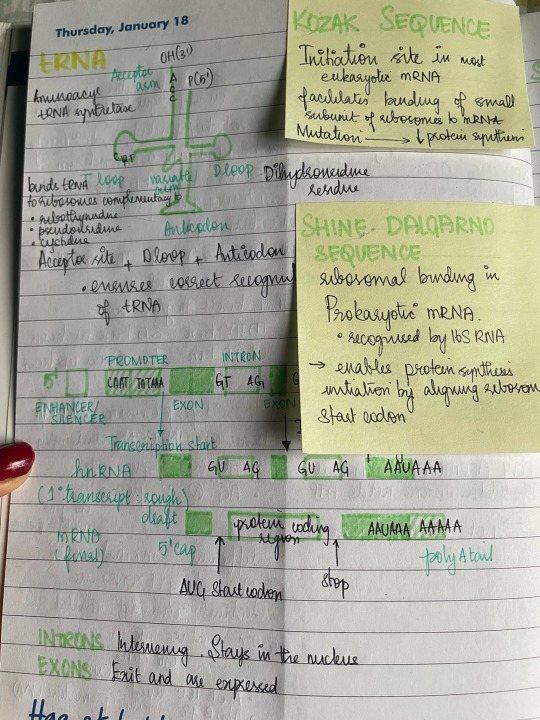

03.07.2023
Was travelling with family last week and fell a lil sick. The weather was wonderful today and I was able to spend a few hours learning. Finally completed uworld block on genetics. Feels like a huge achievement honestly.
#phtooftheday#medstudlife#studyblr#studysthetics#neetpg#medstudynotes#neetpg2023#study mood#first aid#inicet#indian studyblr#desi doctor#desi studyblr#med blog#medblr#medblog#new medblr#studywithme#studyinspo#study notes#studyblr community#light academia#light academic aesthetic#hustle#mbbslife#mbbs in india#study inspiration#study aesthetic#study tumblr#studyspo
459 notes
·
View notes
Text

A group of Indians came to New York from all over the country to celebrate the formation of an aboriginal council, May 19, 1926. They held a pow-wow at the Hotel McAlpin and listened to a speech by Chief Sakokentata of the Mohawk tribe of Caughnawaga, Canada.
Photo: Bettmann Archive/Getty Images/Fine Art America
#vintage New York#1920s#Native Americans#American Indians#Mohawks#aboriginal council#North American aborigines#pow-wow#May 19#vintage NYC#19 May
101 notes
·
View notes
Text
Gharial rescued from sea
Another instance of more recent croc news, a "giant" gharial was found in the Indian Ocean off the coast of Balsore, eastern India.
According to news articles, the animal, an adult Indian Gharial (Gavialis gangeticus), meassured around 13 feet or in metric close to 4 meters in length while weighing some 118 kilos.

The gharial apparently got caught in a fishing net and was found by fishermen, who promptly reported their catch to the Forest Department. The department then handed the animal over to Nandankanan Zoological Park, where the crocodilian still resides.
That's all the information given to us by the article, which you can read here, but there's two key notes I wanna touch upon.
The first is size. At 4 meters, this gharial was decently large for sure and as someone who has seen a (stuffed) female of slightly greater proportions I can attest that it must have been an impressive animal. However, I think its worth mentioning that Indian gharials are capable of growing even larger. The female I just mentioned is accompanied by a stuffed male nearly 5 and a half meters in length, with some reports claiming sizes even greater than that.
Me and the Vienna gharials

The second point is the mysterious presence of a gharial this far out at sea. This is simultaneously unusual yet also very much reasonable from the point of view of paleontology.
On the one hand, Indian gharials are critically endangered. Their range today is incrediply spotty and isolated and to my knowledge they aren't found anywhere near the coast these days.
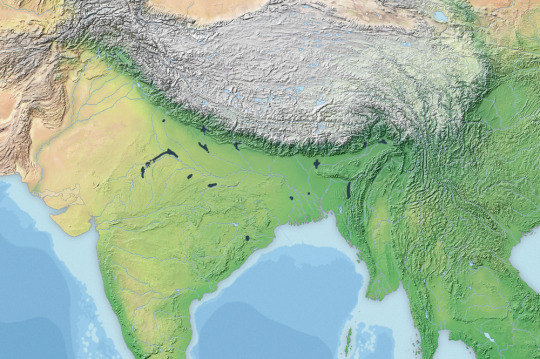

However when you look at how the range was meant to be like, then you see that they definitely reached the river deltas and coastal regions. So our image of gharials as this inland freshwater species is more based in circumstance than reality.
This becomes especially apparent once you begin to consider the paleobiogeography of gharials. Based on our current knowledge, gharials most likely originated somewhere in Eurasia or Africa, spreading from there across much of the eastern hemisphere and beyond (full disclosure I am not considering thoracosaurs to be gavialoids, more on that can of worms later maybe). Anywho, phylogenetic analysis and the fossil record both suggest that gharials then crossed oceans and settled South America sometime prior to or during the Miocene, where they diversified and gave rise to the gryposuchines. Some species even remained saltwater species, such as Piscogavialis, which lived in the coastal waters of Peru.
Although gryposuchines were once thought to be a distinct subfamily of gharial, recent research suggests that they were but an evolutionary stepping stone, with some South American form once again crossing the Pacific and settling down in Asia where the much more basal "tomistomines" or false gharials (a misnomer) still resided. And while the gryposuchines of South America went extinct, those that returned to Asia survived and eventually gave rise to the Indian Gharial of today.
Left: A cladogram showing the relationship between Gryposuchinae and modern gharials
Right: Piscogavialis swimming overhead some marine sloths of the genus Thalassocnus by @knuppitalism-with-ue


So ultimately, seeing a gharial in saltwater is much less bizarre than one would initially think, its just that habitat destruction and overhunting have largely pushed these gorgeous reptiles further inland and to the brink of extinction.
#gharial#indian gharial#gavialis gangeticus#gavialidae#news#croc#crocodilia#crocodile#india#herpetology#gavialinae#gryposuchinae#piscogavialis#some paleontology#palaeoblr
242 notes
·
View notes